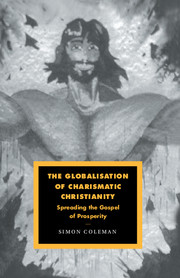Book contents
- Frontmatter
- Contents
- List of illustrations
- Acknowledgements
- Introduction
- Chapter One A ‘weird babel of tongues’: charisma in the modern world
- Chapter Two ‘Faith which conquers the world’: globalisation and charisma
- Chapter Three Sweden: national ‘state’ and global ‘site’
- Chapter Four The Word of Life: organising global culture
- Chapter Five Words: from narrative to embodiment
- Chapter Six Aesthetics: from iconography to architecture
- Chapter Seven Broadcasting the faith
- Chapter Eight Expansive agency
- Chapter Nine Contesting the nation
- Chapter Ten The Word and the world
- References
- Index
Chapter Four - The Word of Life: organising global culture
Published online by Cambridge University Press: 22 September 2009
- Frontmatter
- Contents
- List of illustrations
- Acknowledgements
- Introduction
- Chapter One A ‘weird babel of tongues’: charisma in the modern world
- Chapter Two ‘Faith which conquers the world’: globalisation and charisma
- Chapter Three Sweden: national ‘state’ and global ‘site’
- Chapter Four The Word of Life: organising global culture
- Chapter Five Words: from narrative to embodiment
- Chapter Six Aesthetics: from iconography to architecture
- Chapter Seven Broadcasting the faith
- Chapter Eight Expansive agency
- Chapter Nine Contesting the nation
- Chapter Ten The Word and the world
- References
- Index
Summary
The flat landscape around Uppsala is dominated by the profiles of two ancient buildings, which lie close to each other in the centre of the city. One is the medieval cathedral, housing the tombs of a number of famous scholars and kings. The other is a castle, originally designed as a stronghold in the 1540s by Gustav Vasa, the king renowned for having brought the Protestant Reformation to Sweden. Located alongside these buildings are departments of Uppsala's venerable university and a number of museums, forming a heritage complex on the city's only hill. Across the river in the commercial district are most of the free churches, many of them founded in the late nineteenth and early twentieth centuries at a time of increasing industrialisation and democratisation.
The casual visitor is not likely to be encouraged to visit an area on the eastern border of town, away from the historic landmarks, shops and fashionable suburbs. Here is situated a large industrial estate, whose high-rise offices and warehouses are beginning to clutter up some of the skyline previously monopolised by the castle and cathedral. Most of these newer buildings have sacrificed architectural beauty for the sake of cost-effectiveness. One structure does stand out from the rest, however. It is composed of concrete, metal and glass, and its walls are a gleaming white colour (Figure 1). Outside, a large sign proclaims the corporate identity of the occupants: the Word of Life (Livets Ord).
- Type
- Chapter
- Information
- The Globalisation of Charismatic Christianity , pp. 87 - 116Publisher: Cambridge University PressPrint publication year: 2000

